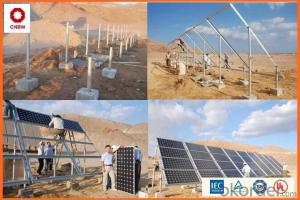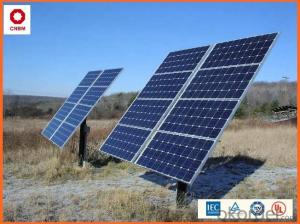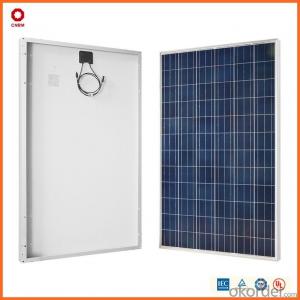80w Small Solar Panels in Stock - Solar Energy Systems Canberra - China Manufacturer
- Loading Port:
- China main port
- Payment Terms:
- TT OR LC
- Min Order Qty:
- 1 watt
- Supply Capability:
- 10000000 watt/month
OKorder Service Pledge
OKorder Financial Service
You Might Also Like
Specification
Product Description:
Hot Sale !!! Quality and Safety of Small Poly Solar Panel 5w~150w
1. Rigorous quality control meets the highest international standards.
2. High-transmissivity low-iron tempered glass, strong aluminium frame.
3. Using UV-resistant silicon.
4. IS09001/14001/CE/TUV/UL
Warranties of Small Poly Solar Panel 35~85w
1. 10 years limited product warranty
2. 15 years at 90% of the minimal rated power output
3. 25 years at 80% of the minimal rated power output
Specification
Characteristics of Poly solar panels CNBM (245-320W) | |||||
Max Power Voltage Vmp(V) | 30.3 | 30.8 | 31.1 | 31.4 | 31.85 |
Max Power Current Imp(A) | 7.60 | 7.64 | 7.73 | 7.81 | 7.85 |
Open Circuit Voltage Voc(V) | 36.1 | 36.6 | 37 | 37.3 | 37.68 |
Short Circuit Current Isc(A) | 8.50 | 8.55 | 8.65 | 8.75 | 8.85 |
Max Power Pm(W) | 230W | 235W | 240W | 245W | 250W |
Temperature Coefficient of Cells Poly solar panels CNBM (245-320W) | |
NOCT | 45± 2 |
Temperature Coeffucients of Isc | 0.0492 |
Temperature Coeffucients of Voc | -0.3374 |
Temperature Coeffucients of Voc | -0.4677 |
Mechanical Data of Poly solar panels CNBM (245-320W) | |
Dimension | 1638 × 982 × 40 mm |
Weight | 19.5 kg |
No. of Cells and Connections | 60 (6 ×10) |
Tolerance | 0 ~ + 5 W |
Cell | Monocrystalline Cell 156 × 156 mm |
Packing | 624 Pcs/40ft(H) Container |
Limits of Poly solar panels CNBM (245-320W) | |
Operating Temperature | -40 to +85 |
Storage Temperature | -40 to +85 |
Max System Voltage | 1000VDC(IEC) / 600VDC(UL) |
Features of our products:
• High conversion efficiency mono/poly-crystalline amorphous silicon solar cells
• Modules incorporate high performance bypass diodes to minimize the power drop caused by shading
• High transmittance, low-iron tempered glass
• High performance EVA encapsulant to prevent destroying and water.
• AI frame: without screw, corner connection. 8 holes on the frame can be installed easily
• Good performance of preventing from atrocious weather such as wind and hails
• Certifications: CE IEC TUV VDE UL, Class I
• 10 years 90% power output warranty

Shipping of Small Poly Solar Panel 35~85w
By Sea | Delivery from Shanghai or Ningbo seaport |
By Air | Departure from Shanghai Pudong Airport |
By Express | Post by DHL, EMS, UPS, TNT. |
Features of our products:
• High conversion efficiency mono/poly-crystalline amorphous silicon solar cells
• Modules incorporate high performance bypass diodes to minimize the power drop caused by shading
• High transmittance, low-iron tempered glass
• High performance EVA encapsulant to prevent destroying and water.
• AI frame: without screw, corner connection. 8 holes on the frame can be installed easily
• Good performance of preventing from atrocious weather such as wind and hails
• Certifications: CE IEC TUV VDE UL, Class I
• 10 years 90% power output warranty
As a professional Solar Panel manufacturer and Supplier in China, we have our customers come around the whole world and our specialization has got a worldwide recognition. Meanwhile, with our superior quality, competitive price, prompt and excellent service, As main role in trade section of CNBM Group, CNBM International Corporation supplies products including Monocrystalline Solar Panel, Polycrystalline Solar Panel ( multicrystalline silicon Solar Panel) have received and enjoyed famous reputation in many countries and regions in the world.
- Q: Are there any noise concerns associated with solar energy systems?
- Yes, there are minimal noise concerns associated with solar energy systems. Unlike traditional energy sources such as generators or wind turbines, solar panels do not produce any noise while generating electricity. This makes solar energy systems a quiet and peaceful option for harnessing renewable energy.
- Q: Can solar energy systems be used in areas with limited access to solar energy community initiatives?
- Yes, solar energy systems can still be used in areas with limited access to solar energy community initiatives. While it may be more challenging to implement large-scale solar projects in areas with limited solar resources, individual households or businesses can still benefit from smaller solar energy systems, such as rooftop solar panels. These systems can help generate electricity locally, reducing reliance on traditional energy sources and contributing to a more sustainable energy future. Additionally, advancements in solar technology, such as more efficient panels and energy storage solutions, can further improve the viability of solar energy systems in areas with limited access to solar energy community initiatives.
- Q: Can solar energy systems be used in powering street cameras or surveillance systems?
- Street cameras and surveillance systems can indeed be powered by solar energy systems. Solar energy is a reliable and independent source of power that is sustainable and renewable. To utilize solar energy, one can install solar panels on rooftops or mount them on poles near the cameras. These panels capture sunlight and convert it into electricity, which can then be stored in batteries. This stored electricity can be used to power the cameras and surveillance systems even when sunlight is scarce or at night. By utilizing solar energy for street cameras and surveillance systems, we not only reduce our reliance on traditional power sources but also contribute to reducing carbon emissions and minimizing our overall environmental impact. Moreover, solar-powered systems prove to be cost-effective in the long run as they eliminate the need for expensive cabling and provide a self-sustaining energy solution. In conclusion, solar energy systems are an excellent choice for powering street cameras and surveillance systems due to their sustainability, reliability, cost-efficiency, and environmental friendliness.
- Q: Can solar energy systems be used in powering mining operations?
- Yes, solar energy systems can be used to power mining operations. Solar panels can be installed near mining sites to capture sunlight and convert it into electricity, which can then be used to power various equipment and machinery required for mining operations. This helps reduce dependence on fossil fuels, lowers operational costs, and minimizes environmental impact associated with traditional power sources.
- Q: Can solar energy systems be used in powering hotels or resorts?
- Yes, solar energy systems can certainly be used to power hotels or resorts. Solar power is a clean and renewable energy source that can provide ample electricity to meet the energy demands of hotels and resorts. These establishments typically require a significant amount of energy for various purposes such as lighting, heating, cooling, and operating electrical appliances and equipment. Installing solar panels on the rooftops or in open areas of hotels and resorts can allow them to harness the abundant sunlight and convert it into electricity. This electricity can be used to power the entire facility, reducing the reliance on traditional energy sources and lowering the carbon footprint. In addition to being environmentally friendly, solar energy systems can also provide financial benefits to hotels and resorts. By generating their own electricity, these establishments can reduce or even eliminate their utility bills, resulting in substantial cost savings over time. Moreover, some countries offer incentives, grants, or tax credits for implementing solar power systems, further enhancing the economic viability of such installations. Furthermore, the availability of solar energy is not limited to sunny days. With advancements in technology, solar panels can still generate electricity even during cloudy or overcast conditions. Additionally, excess energy produced during peak sunlight hours can be stored in batteries for later use, ensuring a consistent power supply throughout the day and night. By adopting solar energy systems, hotels and resorts can showcase their commitment to sustainability and environmental responsibility. This can be a valuable marketing tool, attracting eco-conscious guests who prefer environmentally friendly accommodations. It also aligns with the growing trend of sustainable tourism, which can enhance the reputation and competitiveness of these establishments in the industry. Overall, solar energy systems are a viable and efficient solution for powering hotels and resorts. They offer numerous benefits, including reduced utility costs, environmental sustainability, and enhanced market appeal. As the technology continues to evolve and become more affordable, more and more hotels and resorts are embracing solar power as a clean and reliable energy source.
- Q: Can solar energy systems be installed in areas with high winds?
- Yes, solar energy systems can be installed in areas with high winds. However, it is important to design and install them properly to withstand the wind loads. This can involve using strong mounting structures, reinforced fasteners, and aerodynamic panel designs. Additionally, regular maintenance and inspections are crucial to ensure the system remains secure and functional in such conditions.
- Q: What is the difference between a solar lease and a solar purchase?
- A solar lease involves renting the solar panels from a third-party provider, typically with no upfront costs but with monthly lease payments. On the other hand, a solar purchase involves buying the solar panels outright, either through a loan or with cash, and owning the system. With a purchase, there may be upfront costs, but the homeowner receives financial benefits such as tax credits and energy savings.
- Q: What is the role of solar water pumps in solar energy systems?
- The role of solar water pumps in solar energy systems is to utilize solar power to pump water for various applications such as irrigation, livestock watering, and domestic use. These pumps are designed to operate efficiently using solar energy, reducing dependence on grid electricity and minimizing both operational costs and environmental impact. Solar water pumps play a vital role in harnessing the renewable energy potential of the sun and providing sustainable water solutions in off-grid and remote areas.
- Q: Can a solar energy system be installed on a church or religious building?
- Yes, a solar energy system can be installed on a church or religious building. In fact, many religious organizations have started to embrace solar energy as a sustainable and environmentally friendly solution to reduce their carbon footprint and lower their energy costs. Installing solar panels on the roof of a church or religious building can generate clean and renewable energy, which can be used to power the facility and reduce its reliance on traditional energy sources. Additionally, by going solar, religious organizations can set an example for their communities and inspire others to adopt clean energy practices.
- Q: How do solar energy systems impact public health?
- Solar energy systems have a positive impact on public health. They reduce air pollution associated with fossil fuel combustion, leading to improved air quality and decreased respiratory diseases. Additionally, solar energy systems do not produce hazardous waste or emissions, reducing the risk of water and soil contamination. Overall, the adoption of solar energy systems promotes a healthier environment and enhances public health outcomes.
Send your message to us
80w Small Solar Panels in Stock - Solar Energy Systems Canberra - China Manufacturer
- Loading Port:
- China main port
- Payment Terms:
- TT OR LC
- Min Order Qty:
- 1 watt
- Supply Capability:
- 10000000 watt/month
OKorder Service Pledge
OKorder Financial Service
Similar products
Hot products
Hot Searches
Related keywords






























